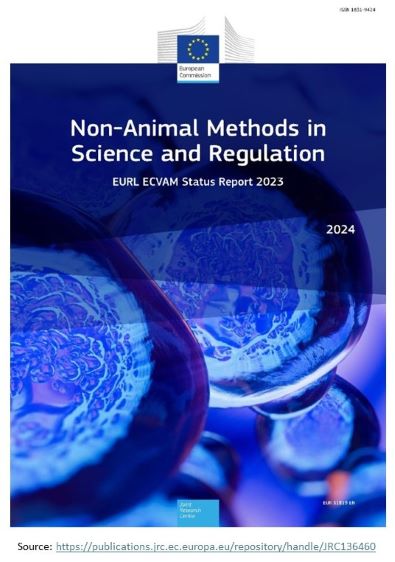Highlights from EURL ECVAM's 2023 Status Report
The European Union Reference Laboratory for Alternatives to Animal Testing (EURL ECVAM) at the Joint Research Centre (JRC) is a key actor in stimulating the development and use of new approach methodologies (NAMs) in Europe. The activities performed by ECVAM in 2023 are described in the annual status report that has been released last month.
Development
In 2023, EURL ECVAM continued its collaborations with various European projects involved in the development of non-animal testing methods: the ASPIS cluster grouping ONTOX, PrecisionTox and RISK-HUNT3R, the Partnership for the Assessment of Risks from Chemicals (PARC), the EURION cluster, the Virtual Human Platform for Safety Assessment (VPH4Safety) and In Silico World (ISW). Additionally, ECVAM established an international working group at the OECD in order to draft a guidance document on the characterisation, validation and reporting of Physiologically Based Kinetic models. This document was further promoted during dedicated training courses.
Validation
Validation of alternative methods is an important step to ensure their compliance with regulatory requirements and to facilitate their acceptance and integration into regulatory frameworks. In this area, ECVAM has been involved in updating the OECD GD 34 on the validation and international acceptance of new or updated test methods for hazard assessment. In addition, ECVAM and the EU Network of Laboratories for the Validation of Alternative Methods (EU-NETVAL) started the final stage of the validation study of a battery of in vitro methods for the assessment of thyroid hormone disruption. ECVAM also initiated the validation study of the high throughput androgen receptor dimerisation assay, which can be used to identify compounds that interfere with androgens.
Regulatory application
In the regulatory domain, EURL ECVAM supported different EU policies in the fields of chemicals, pharmaceuticals, toys, medical devices, and cosmetics. Regarding chemicals for example, EURL ECVAM proposed the ‘Chemicals 2.0’ regulatory framework aiming at establishing a simpler classification system that could be applied to all chemicals on the market, and that would maintain the current levels of protection of human health and environment while supporting the ‘sustainability by design’ approach. This framework served as a basis for the European Partnership for Alternative Approaches to Animal Testing (EPAA) ‘Designathon’ for human systemic toxicity which explored new concepts for integrating NAMs into hazard classification systems.
Alternatives in research and education
In the fields of biomedical research and education, EURL ECVAM focused on promoting the use of NAMs within the scientific community. Initiatives launched in 2023 include:
- Launch of a pilot project for an automated database leveraging artificial intelligence and machine learning to collect information on NAMs,
- Release of draft recommendations to enhance methodological clarity in life sciences publications,
- Application of Adverse Outcome Pathways (AOP) as a model for COVID-19 pathogenesis (CIAO project),
- Organisation of the JRC Summer School on Non-Animal Approaches in Science themed ‘Towards sustainable innovation’,
- Establishment of a virtual reality laboratory for primary and secondary schools.
Conclusion
The different initiatives undertaken by EURL ECVAM in 2023 align with the European Commission’s roadmap to phase out animal testing in response to the European Citizens’ Initiative ‘Save Cruelty-Free Cosmetics – Commit to a Europe without Animal Testing’. Particular emphasis was put on advancing validation of NAMs, training, education and collaborations to advance the development and use of NAMs.
Resources:
- Link to download the full report: https://publications.jrc.ec.europa.eu/repository/handle/JRC136460
- Highlights of the 2023 Status Report: https://joint-research-centre.ec.europa.eu/jrc-news-and-updates/alternatives-animal-testing-jrc-2023-status-report-out-2024-03-12_en
- Mechanistic Analysis of Repeated Dose Toxicity Studies: https://publications.jrc.ec.europa.eu/repository/handle/JRC132210
- EPAA Designathon for human systemic toxicity: https://single-market-economy.ec.europa.eu/calls-expression-interest/epaa-launches-designathon-human-systemic-toxicity_en
- Modelling the Pathogenesis of COVID-19 Using the Adverse Outcome Pathway Framework (CIAO Project): https://www.ciao-covid.net/findings
- Report on the outcome of the JRC Summer School 2023 on Non-Animal Approaches in Science: https://publications.jrc.ec.europa.eu/repository/handle/JRC135377
- Three Rs educational resources for primary and secondary schools: https://www.scientix.eu/projects/steam-partnerships/3rs
- European Citizens Initiative ‘Save Cruelty-Free Cosmetics – Commit to a Europe without Animal Testing’: https://citizens-initiative.europa.eu/save-cruelty-free-cosmetics-commit-europe-without-animal-testing_en


